- Orsanmichele
-
Orsanmichele (or "Kitchen Garden of St. Michael", from the contraction in Tuscan dialect of the Italian word orto) is a church in the Italian city of Florence. The building was constructed on the site of the kitchen garden of the monastery of San Michele, which is now gone.
Located on the Via Calzaiuoli in Florence, the church was originally built as a grain market[1] in 1337 by Francesco Talenti, Neri di Fioravante, and Benci di Cione. Between 1380 and 1404 it was converted into a church used as the chapel of Florence's powerful craft and trade guilds. On the ground floor of the square building are the 13th century arches that originally formed the loggia of the grain market. The second floor was devoted to offices, while the third housed one of the city's municipal grain storehouses, maintained to withstand famine or siege.[1] Late in the 14th century, the guilds were charged by the city to commission statues of their patron saints to embellish the facades of the church.[1] The sculptures seen today are copies, the originals having been removed to museums (see below).
Contents
Interior
Inside the church is Andrea Orcagna's bejeweled Gothic Tabernacle (1355-59) encasing a repainting by Bernardo Daddi's of an older icon of the 'Madonna and Child'.[2]
Exterior
The facades held 14 architecturally designed external niches, which were filled from 1399 to around 1430. The three richest guilds opted to make their figures in the far more costly bronze, which cost approximately ten times the amount of the stone figures.
Niche Statue Sculptor Guild Year Notes 
Virgin and Child Simone di Ferrucci Medici e Speziali
(doctors and apothecaries)1399 
Quattro Santi Coronati
(Four Crowned Martyrs or Four Saints)Nanni di Banco Maestri di Pietra e Legname
(wood and stone workers) maybe a statue to a group? the freemasons?1408 [3][4] 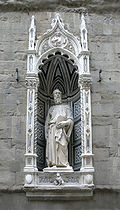
St. Mark Donatello Arte dei Linaiuoli e Rigattieri
(linen-weavers and peddlers)1411 [5][6] 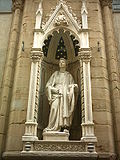
St. Philip Nanni di Banco Arte dei Calzaiuoli
(shoemakers)1412-14 [7][8] 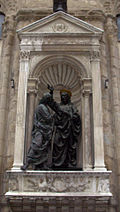
Christ and St. Thomas Andrea del Verrocchio Tribunale di Mercanzia
(merchants)1467-83 Replaced St. Louis of Toulouse by Donatello (1413)[9][10][11] 
St. Eligius Nanni di Banco Arte dei Maniscalchi
(farriers)1411-15 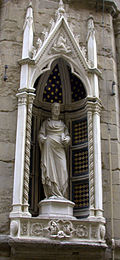
St. James Niccolò di Piero Lamberti Arte dei Pellicciai
(furriers)1415 Attribution and year are uncertain 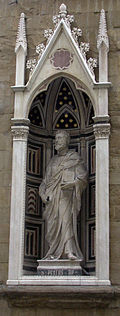
St. Peter Ciuffagni Arte dei Beccai
(butchers)1415 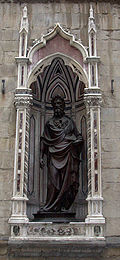
St. John the Baptist Lorenzo Ghiberti Arte di Calimala
(wool mechants)1414-16 [12] 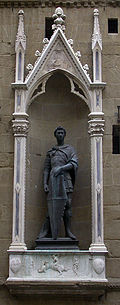
St. George Donatello Arte dei Corazzai
(armourers)1416 [13][14] St. Matthew Lorenzo Ghiberti Arte del Cambio
(bankers)1419-20 [15][16] 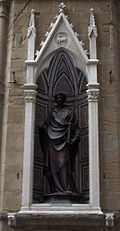
St. Stephen Lorenzo Ghiberti Arte della Lana
(wool manufacturers)1428 [17] 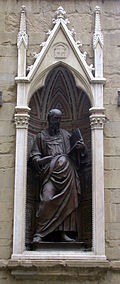
St. John the Evangelist Baccio da Montelupo Arte della Seta
(silk merchants)1514 
St. Luke Giambologna Giudici e Notai
(magistrates and notaries)1601 [18] Modern assessment
Orsanmichele's statuary is a relic of the fierce devotion and pride of Florentine trades, and a reminder that great art often arises out of a competitive climate. Each trade hoped to outdo the other in commissioning original, groundbreaking sculptures for public display on Florence's most important street, and the artists hired and materials used (especially bronze) indicate the importance that was placed on this site.
Today, all of the original sculptures have been removed and replaced with modern duplicates to protect them from the elements and vandalism.[19] The originals mainly reside in the museum of Orsanmichele, which occupies the upper floor of the church, although the museum is indefinitely closed as of early 2007[update]. Two works by Donatello are in other Florentine museums: St. George and its niche are in the Bargello, and St. Louis of Toulouse is in the museum of the Basilica di Santa Croce.
References
- ^ a b c Zucconi, Guido (1995). Florence: An Architectural Guide. San Giovanni Lupatoto, Vr, Italy: Arsenale Editrice srl. ISBN 88-7743-147-4.
- ^ "The Orsanmichele Market in Time of Famine". The National Gallery of Art. http://www.nga.gov/exhibitions/2005/orsanmichele/images/illumination-fs.shtm. Retrieved July 14, 2006.
- ^ "Nanni Di Banco". The National Gallery of Art. http://www.nga.gov/exhibitions/2005/orsanmichele/nanni.shtm. Retrieved July 14, 2006.
- ^ Sullivan, Mary Ann (July 10, 2005). "Four Crowned Saints (or Four Crowned Martyrs) and relief at base of tabernacle, Orsanmichele". Orsanmichele. Digital Imaging Project: Art historical images of European and North American architecture and sculpture from classical Greek to Post-modern. http://www.bluffton.edu/~sullivanm/orsanmichele/nanni.html. Retrieved July 14, 2006.
- ^ Sullivan, Mary Ann (July 10, 2005). "St. Mark, Orsanmichele". Orsanmichele. Digital Imaging Project: Art historical images of European and North American architecture and sculpture from classical Greek to Post-modern. http://www.bluffton.edu/~sullivanm/orsanmichele/stmark.html. Retrieved July 14, 2006.[dead link]
- ^ Kren, Emil; Marx, Daniel (June 22, 2006). "St Mark". Web Gallery of Art. http://www.wga.hu/frames-e.html?/html/d/donatell/1_early/orsanmic/2mark_1.html. Retrieved July 14, 2006.
- ^ Sullivan, Mary Ann (July 10, 2005). "St. Philip, Orsanmichele". Orsanmichele. Digital Imaging Project: Art historical images of European and North American architecture and sculpture from classical Greek to Post-modern. http://www.bluffton.edu/~sullivanm/orsanmichele/nanniphilip.html. Retrieved July 14, 2006.
- ^ "St. Philip" (JPG). http://employees.oneonta.edu/farberas/arth/Images/ARTH213images/Orsanmichele/NannidiBanco_Quattro.jpg. Retrieved July 14, 2006.
- ^ Sullivan, Mary Ann (July 10, 2005). "Christ and St. Thomas (or Doubting of Thomas), Orsanmichele". Orsanmichele. Digital Imaging Project: Art historical images of European and North American architecture and sculpture from classical Greek to Post-modern. http://www.bluffton.edu/~sullivanm/orsanmichele/verrocchio.html. Retrieved July 14, 2006.
- ^ "Verrocchio". The National Gallery of Art. http://www.nga.gov/exhibitions/2005/orsanmichele/verrocchio.shtm. Retrieved July 14, 2006.
- ^ Kren, Emil; Marx, Daniel (June 22, 2006). "St Louis". Web Gallery of Art. http://www.wga.hu/frames-e.html?/html/d/donatell/1_early/orsanmic/2louis_1.html. Retrieved July 14, 2006.
- ^ Sullivan, Mary Ann (July 10, 2005). "St. John the Baptist". Orsanmichele. Digital Imaging Project: Art historical images of European and North American architecture and sculpture from classical Greek to Post-modern. http://www.bluffton.edu/~sullivanm/orsanmichele/ghiberti.html. Retrieved July 14, 2006.
- ^ Sullivan, Mary Ann (July 10, 2005). "St. George (bronze copy of the original marble) and relief at the base of the tabernacle, Orsanmichele". Orsanmichele. Digital Imaging Project: Art historical images of European and North American architecture and sculpture from classical Greek to Post-modern. http://www.bluffton.edu/~sullivanm/orsanmichele/donatellogeorge.html. Retrieved July 14, 2006.
- ^ Kren, Emil; Marx, Daniel (June 22, 2006). "St George". Web Gallery of Art. http://www.wga.hu/frames-e.html?/html/d/donatell/1_early/orsanmic/1georg_1.html. Retrieved July 14, 2006.
- ^ "St. Matthew" (JPG). http://employees.oneonta.edu/farberas/arth/Images/ARTH213images/Orsanmichele/Ghiberti_StMatthew.jpg. Retrieved July 14, 2006.
- ^ "Ghiberti". The National Gallery of Art. http://www.nga.gov/exhibitions/2005/orsanmichele/ghiberti.shtm. Retrieved July 14, 2006.
- ^ "St. Stephen" (JPG). http://employees.oneonta.edu/farberas/arth/Images/ARTH213images/Orsanmichele/Ghiberti_StStephen.jpg. Retrieved July 14, 2006.
- ^ Sullivan, Mary Ann (July 10, 2005). "St. Luke". Orsanmichele. Digital Imaging Project: Art historical images of European and North American architecture and sculpture from classical Greek to Post-modern. http://www.bluffton.edu/~sullivanm/orsanmichele/bolognaluke.html. Retrieved July 14, 2006.
- ^ "Orsanmichele". Foundation For Italian Art and Culture. November 9, 2005. http://www.fiacfoundation.org/HTML/projects/current/orsanmichele.html. Retrieved July 14, 2006.
External links
- Sullivan, Mary Ann (July 10, 2005). "Orsanmichele". Digital Imaging Project: Art historical images of European and North American architecture and sculpture from classical Greek to Post-modern. http://www.bluffton.edu/~sullivanm/orsanmichele/orsanmichele.html. Retrieved July 14, 2006.
- "Orsanmichele". Florence Art Guide. http://www.mega.it/eng/egui/monu/orsmch.htm. Retrieved July 14, 2006.
- "Monumental Sculpture from Renaissance Florence". The National Gallery of Art. http://www.nga.gov/exhibitions/2005/orsanmichele/index.shtm. Retrieved July 14, 2006.
Coordinates: 43°46′14.73″N 11°15′18.61″E / 43.7707583°N 11.2551694°E
Religious sites Battistero | Brancacci Chapel | Orsanmichele | San Lorenzo | San Marco | San Miniato | Santa Croce | Santa Maria del Fiore | Santa Maria Novella | Santo Spirito | Great SynagogueMuseums, galleries, and palaces Notable landmarks Giotto's Campanile | Ponte Vecchio | TheatresGardens and parks Categories:- Churches in Florence
- 1337 establishments
- Gothic architecture in Tuscany
Wikimedia Foundation. 2010.



